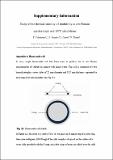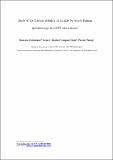Por favor, use este identificador para citar o enlazar a este item:
http://hdl.handle.net/10261/162629COMPARTIR / EXPORTAR:
 SHARE SHARE
 CORE
BASE CORE
BASE
|
|
| Visualizar otros formatos: MARC | Dublin Core | RDF | ORE | MODS | METS | DIDL | DATACITE | |

| Título: | Study of the thermal stability of studtite by in situ Raman spectroscopy and DFT calculations |
Autor: | Colmenero, Francisco CSIC ORCID; Bonales, L. J.; Cobos, Joaquín CSIC ORCID; Timón, Vicente CSIC ORCID | Palabras clave: | Structure thermal stability DFT Raman spectroscopy Studtite Spent fuel |
Fecha de publicación: | 29-nov-2016 | Editor: | Elsevier | Citación: | Spectrochimica Acta - Part A: Molecular and Biomolecular Spectroscopy 174: 245-253 (2017) | Resumen: | The design of a safe spent nuclear fuel repository requires the knowledge of the stability of the secondary phases which precipitate when water reaches the fuel surface. Studtite is recognized as one of the secondary phases that play a key-role in the mobilization of the radionuclides contained in the spent fuel. Thereby, it has been identified as a product formed under oxidation conditions at the surface of the fuel, and recently found as a corrosion product in the Fukushima-Daiichi nuclear plant accident. Thermal stability is one of the properties that should be determined due to the high temperature of the fuel. In this work we report a detailed analysis of the structure and thermal stability of studtite. The structure has been studied both by experimental techniques (SEM, TGA, XRD and Raman spectroscopy) and theoretical DFT electronic structure and spectroscopic calculations. The comparison of the results allows us to perform for the first time the Raman bands assignment of the whole spectrum. The thermal stability of studtite has been analyzed by in situ Raman spectroscopy, with the aim of studying the effect of the heating rate and the presence of water. For this purpose, a new cell has been designed. The results show that studtite is stable under dry conditions only at temperatures below 30 °C, in contrast with the higher temperatures published up to date (~ 130 °C). Opposite behaviour has been found when studtite is in contact with water; under these conditions studtite is stable up to 90 °C, what is consistent with the encounter of this phase after the Fukushima-Daiichi accident. | Descripción: | 9 pags., 10 figs., 3 tabs., app. | Versión del editor: | https://doi.org/10.1016/j.saa.2016.11.040 | URI: | http://hdl.handle.net/10261/162629 | DOI: | 10.1016/j.saa.2016.11.040 | Identificadores: | doi: 10.1016/j.saa.2016.11.040 issn: 1386-1425 |
| Aparece en las colecciones: | (CFMAC-IEM) Artículos |
Ficheros en este ítem:
| Fichero | Descripción | Tamaño | Formato | |
|---|---|---|---|---|
| Colmenero et al_studtire_suo_inf_2016_spac_revised.pdf | 848,03 kB | Adobe PDF |  Visualizar/Abrir | |
| Colmenero et al_studtire_2016_spac_revised.pdf | 1,6 MB | Adobe PDF |  Visualizar/Abrir |
CORE Recommender
SCOPUSTM
Citations
43
checked on 16-abr-2024
WEB OF SCIENCETM
Citations
43
checked on 20-feb-2024
Page view(s)
317
checked on 23-abr-2024
Download(s)
561
checked on 23-abr-2024
Google ScholarTM
Check
Altmetric
Altmetric
Este item está licenciado bajo una Licencia Creative Commons

